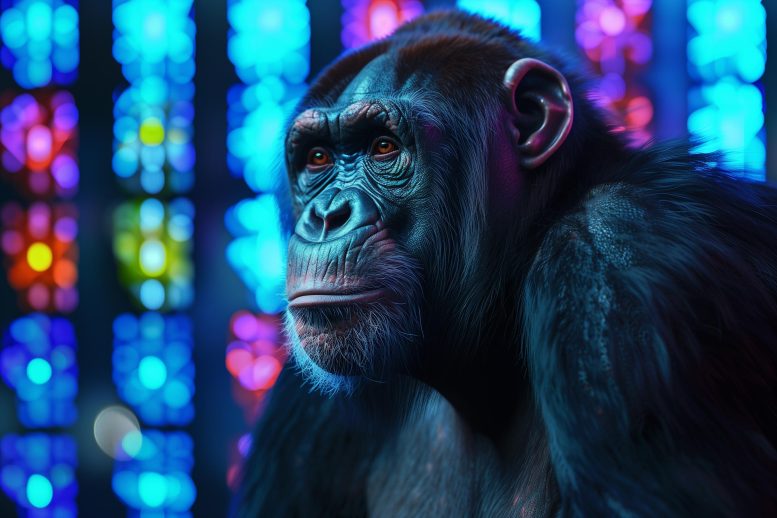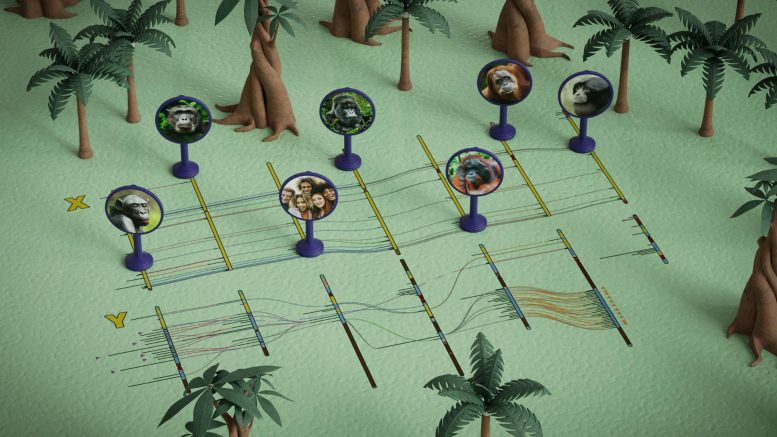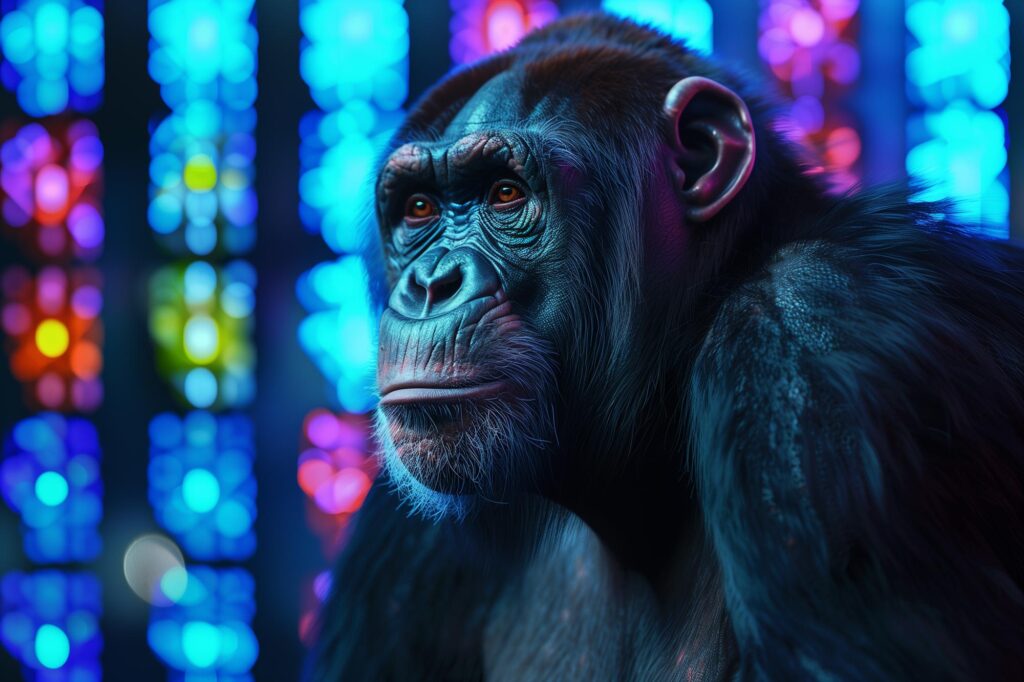
Researchers have sequenced the complete X and Y chromosomes of several great ape species, revealing significant evolutionary changes, particularly on the rapidly evolving Y chromosome. This study, highlighting stable and dynamic genomic regions, provides new insights into the evolution of primates and humans, as well as the conservation of these endangered species. Credit: SciTechDaily.com
Complete X and Y chromosome sequences from six different primates species have been successfully mapped, revealing a rich diversity among these species and providing deeper insights into their evolutionary processes. This extensive genomic map highlights the unique and shared characteristics of these species, providing a clearer understanding of their evolutionary trajectories.
A team of scientists funded by National Institute of Health (NIH) has generated the first complete sequences of chromosomes from nonhuman primates. Published today (May 29) in the magazine Nature, these sequences reveal remarkable variation between the Y chromosomes of different species, indicating rapid evolution, in addition to revealing previously unstudied regions of great ape genomes. Since these primate species are humans’ closest living relatives, the new sequences could provide insights into human evolution.
The researchers focused on the X and Y chromosomes, which play roles in sexual development and fertility, among many other biological functions. They sequenced chromosomes from five species of great apes, chimpanzees, bonobos, gorillas, and Bornean and Sumatran orangutans, as well as another primate species more distantly related to humans, the siamang gibbon.
“These chromosome sequences add a significant amount of new information,” said Brandon Pickett, Ph.D., a postdoctoral fellow at the National Human Genome Research Institute (NHGRI), part of the NIH, and an author of the study. “Only the chimpanzee genome sequence was fairly complete before this, but even that still had large gaps, particularly in repetitive regions DNA.”

Complete X and Y chromosome sequences from six primate species reveal species diversity and insights into evolution. Credit: Ernesto Del Aguila III, National Human Genome Research Institute
Advances in DNA analysis
By analyzing these new sequences, the researchers estimated that 62 to 66% of X chromosomes and 75 to 82% of Y chromosomes are made up of repetitive DNA sequences. These sequences are much more challenging for scientists to characterize, and the study of repetitive DNA has only become possible in recent years due to new DNA sequencing technologies and analysis methods.
The researchers compared the monkey chromosome sequences with the human X and Y chromosomes to understand their evolutionary histories. Like the human X and Y, the great ape’s Y chromosomes have far fewer genes than the X chromosomes. The researchers also used a computational method called alignment, which shows the regions of the chromosome that have stayed relatively the same over time. evolution, revealing the effects of different evolutionary pressures on different parts of the genome.
The researchers found that over 90% of monkey X chromosome sequences align with the human X chromosome, indicating that X chromosomes have remained relatively unchanged over millions of years of evolution. However, only 14% to 27% of monkey Y chromosome sequences align with the human Y chromosome.
Striking variations in Y chromosomes
“The degree of differences between the Y chromosomes of these species was very surprising,” said Kateryna Makova, Ph.D., a professor at Pennsylvania State University and leader of the study. “Some of these species diverged from the human line only seven million years ago, which is not a long time in terms of evolution. This shows that the Y chromosomes are evolving very quickly.”
One notable difference between primate Y chromosomes is their length. For example, the Y chromosome from the Sumatran orangutan is twice as long as the Y chromosome from the gibbon. Variations in the number and types of DNA repeats account for some of the variation in chromosome length.
One type of repeat is called a palindrome, a DNA sequence that contains inverted DNA repeats. DNA palindromes are similar to linguistic palindromes like “racecar” or “kayak”, in which the letters in the first half of the word are repeated in reverse in the second half of the word, so the sequence of letters is the same before and back. However, DNA palindromes can be over a hundred thousand letters long.
Unique gene variations and future research
The researchers found that DNA palindromes on the primate X and Y chromosomes almost always contain genes that are repeated in multiple copies along the length of the chromosome. Most genes in primate genomes have only two copies, one on each chromosome in a pair. Researchers suspect that having multiple copies in these palindromes helps protect genes, especially on the Y chromosome. Since there is usually only one Y chromosome per cell, if a gene on the Y chromosome is damaged, there is no other chromosome with a copy of it. gene that can be used as a template to repair the damage.
“Having these genes in palindromes is like having a backup,” said Adam Phillippy, Ph.D., a senior investigator at NHGRI and senior author of the study. “We know that many of these genes are performing important functions, and so we expected to see the same genes in palindromes in different species, but this does not appear to be the case.”
The researchers studied several groups of genes contained within palindromes, many of which play a role in sperm production and thus are important for fertility. While palindromes were found on all primate Y chromosomes studied, the specific palindrome sequences and the genes involved in these palindromes were often distinct for each species.
“There may be even more variations that we’re not seeing yet,” said Dr. Phillippy. “On the human Y chromosome, some genes can vary in number between individuals. For each of these other primate species, we are only looking at a single individual. We don’t yet know what the rest of the population looks like and what other variations we might find.”
“However, we have some insights from our group’s previous work that suggest a wide variation in Y chromosome gene copy number in humans and other apes,” added Dr. Makova
These large monkey chromosome sequences also resolve the sequences of another type of repeat called satellite DNA, which is a large stretch of repetitive sequence. Among the chromosomes of the great apes, the researchers identified several previously unknown species-specific satellite sequences.
These sequences provide important insights into the genomes of great apes, as DNA satellites are present throughout the genome. Specifically, they are concentrated near the ends of chromosomes, called telomeres, and in another region called centromeres, which helps chromosomes organize themselves during cell division. The centromere sequences of these species were completely unknown prior to this study and another recent research effort conducted by many of the same researchers.
“Having these satellite sequences from the great apes opens up new territory to explore,” said Dr. Makova, “and similar to our other findings about the Y chromosome, we can see that the centromere of the Y chromosome is very dynamic.”
Implications for conservation and understanding evolution
These chromosome sequences can help researchers study the evolution of great apes, including humans. Researchers are currently working to sequence the entire genomes of these great ape species, but even the X and Y chromosome sequences alone provide many insights, particularly about the evolutionary forces on the Y chromosome that contribute to its rapid evolution.
One factor is that there is usually only one Y chromosome per cell, which leads to the accumulation of changes in the DNA sequence. Another evolutionary force, said Dr. Makova, is a phenomenon known as male mutation bias. Compared to egg production, sperm production involves more DNA replication. With each replication, there is a chance that the DNA sequence will change. This affects all chromosomes, but is particularly affecting the Y chromosome.
Another potential factor is small population size, which may affect rates of evolution. Not only do these monkey species have limited populations in nature, but Y chromosomes are present in only half of the population, further limiting the effective population size of this particular part of the genome.
“It’s important to remember that all of these great ape species are endangered,” said Dr. Makova “Not only can we learn about human evolution from these sequences, but we can apply what we know about their genome and the human genome to better understand the biology and reproduction of these endangered species.”
Reference: “Complete Sequence and Comparative Analysis of Monkey Sex Chromosomes” by Kateryna D. Makova, Brandon D. Pickett, Robert S. Harris, Gabrielle A. Hartley, Monika Cechova, Karol Pal, Sergey Nurk, DongAhn Yoo, Qiuhui Li , Prajna Hebbar, Barbara C. McGrath, Francesca Antonacci, Margaux Aubel, Arjun Biddanda, Matthew Borchers, Erich Bornberg-Bauer, Gerard G. Bouffard, Shelise Y. Brooks, Lucia Carbone, Laura Carrel, Andrew Carroll, Chen Chang -Shan Chin , Daniel E. Cook, Sarah JC Craig, Luciana de Gennaro, Mark Diekhans, Amalia Dutra, Gage H. Garcia, Patrick GS Grady, Richard E. Green, Diana Haddad, Pille Hallast, William T. Harvey, Glenn Hickey , David A .Hillis, Savannah J. Hoyt, Hyeonsoo Jeong, Kaivan Kamali, Sergei L. Kosakovsky Pond, Troy M. LaPolice, Charles Lee, Alexandra P. Lewis, Yong-Hwee E. Loh, Patrick Masterson, Kelly M. McGarvey, Rajiv C. McCoy, Paul Medvedev, Karen H. Miga, Katherine M. Munson, Evgenia Pak, Benedict Paten, Brendan J. Pinto, Tamara Potapova, Arang Rhie, Joana L. Rocha, Fedor Ryabov, Oliver A. Ryder, Samuel Sacco, Kishwar Shafin, Valery A. Shepelev, Viviane Slon, Steven J. Solar, Jessica M. Storer, Peter H. Sudmant, Sweetalana, Alex Sweeten, Michael G. Tassia, Françoise Thibaud-Nissen, Mario Ventura, Melissa A. Wilson, Alice C. Young, Huiqing Zeng, Xinru Zhang, Zachary A. Szpiech, Christian D. Huber, Jennifer L. Gerton, Soojin V. Yi, Michael C. Schatz, Ivan A. Alexandrov, Sergey Koren, Rachel J. O’Neill, Evan E. Eichler and Adam M. Phillippy, May 29, 2024, Nature.
DOI: 10.1038/s41586-024-07473-2



